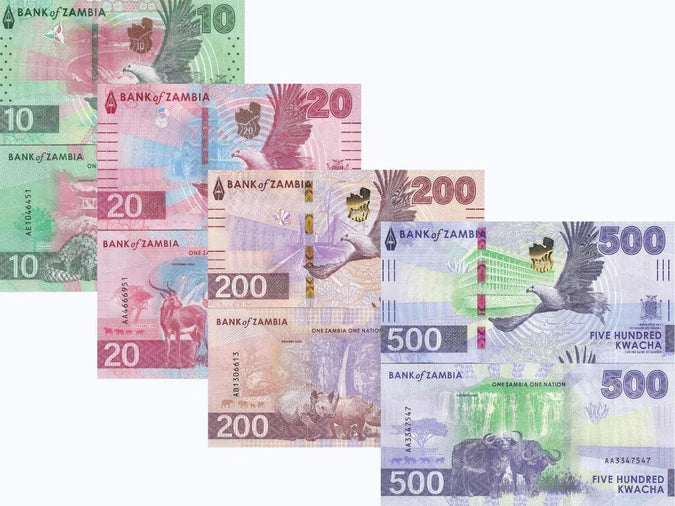When you think of Zambia, perhaps the majestic Victoria Falls or vibrant safari wildlife immediately springs to mind. But Zambia also boasts a colorful history through its fascinating currency, the Zambian Kwacha banknotes. Ever wondered about the story behind these vibrant pieces of paper money? Well, buckle up; you're about to dive into an engaging exploration of Zambia banknotes.

Historical Background
Origins of Zambian Currency
Zambia's modern currency began its journey back in 1968, replacing the Zambian pound. The new currency, known as the "Kwacha," meaning "dawn," symbolized Zambia’s fresh start after gaining independence from British rule in 1964. Cool, right?
Changes Through the Decades
Over time, Zambian banknotes have evolved significantly, with multiple redesigns reflecting the nation's journey. Each series often carries cultural symbolism and the pride of a newly independent country, changing denominations and security elements to stay ahead of counterfeit threats.
Current Zambia Banknotes in Circulation
Let's break down Zambia’s current banknotes you’ll commonly find today:
2 Kwacha Banknote
The smallest denomination still circulating is the 2 Kwacha, typically greenish in color and showcasing Zambia’s agricultural strength with images of maize crops.
5 Kwacha Banknote
The 5 Kwacha highlights Zambia’s rich wildlife, prominently featuring a fish eagle soaring—an emblematic bird of freedom and prosperity.
10 Kwacha Banknote
This note, predominantly purple, presents stunning portrayals of wildlife like the giraffe and iconic indigenous trees, showcasing Zambia’s rich biodiversity.
20 Kwacha Banknote
The vibrant 20 Kwacha note, with a beautiful blue hue, displays the famous Victoria Falls, emphasizing Zambia’s spectacular natural beauty.
50 Kwacha Banknote
The striking 50 Kwacha showcases an impressive leopard, representing Zambia’s powerful wildlife, symbolizing strength and courage.
100 Kwacha Banknote
The largest commonly used denomination, the red-toned 100 Kwacha, honors former Zambian president Kenneth Kaunda, paying tribute to his legacy as Zambia’s founding father.
Features and Security Elements
Zambia doesn’t take security lightly. These banknotes pack some advanced features:
Watermarks and Security Threads
When held against the light, clear watermarks and embedded security threads become visible, verifying authenticity.
Unique Holograms
Holographic elements provide an extra layer of security, shimmering and shifting as you tilt the note.
Color Shifting Inks
Tilt any higher-denomination banknote, and you'll notice colors subtly shift—another clever anti-counterfeiting measure.
Banknote Designs and Symbolism
Images of Prominent Leaders
Zambian currency often commemorates significant leaders who’ve shaped the nation, like Kenneth Kaunda, reflecting national pride and heritage.
Wildlife and Nature Themes
Banknotes consistently celebrate Zambia’s biodiversity—leopards, giraffes, and eagles symbolize the nation’s rich natural heritage.
Cultural and Historical Imagery
Zambian notes also feature traditional artifacts and cultural imagery, reinforcing the importance of cultural identity.
Printing and Regulation Authority
The Role of Bank of Zambia (BoZ)
The Bank of Zambia is the official regulatory body responsible for printing, distribution, and maintaining monetary stability—keeping Zambia’s economy healthy and secure.
Exchange Rates and Value
Understanding the Kwacha's Stability
While historically volatile, the Kwacha’s value has stabilized recently, reflecting Zambia’s improving economic conditions.
Impact on Zambia’s Economy
Fluctuations in the Kwacha’s value significantly affect international trade, tourism, and daily life, influencing Zambia’s broader economic picture.
Collecting Zambia Banknotes
Why Collectors Love Zambia’s Currency
Collectors worldwide adore Zambian banknotes because of their vibrant designs, historical significance, and cultural representations—making them unique treasures.
Tips for Starting a Collection
Start small, focus on specific eras or themes, and always buy from reputable dealers. Collecting can be fun and potentially profitable!
How to Identify Genuine Zambia Banknotes
Practical Tips for Verification
Always check watermarks, security threads, and color-shifting inks. If something feels off, it probably is.
Common Misconceptions About Zambia Banknotes
Myth-busting Popular Misunderstandings
Some mistakenly believe older Zambian notes hold no value—wrong! Vintage notes often carry historical or collectible value, far beyond face value.
Future of Zambia Banknotes
Potential for Digital Currency
Zambia, like many nations, is exploring digital currency options. Could the Kwacha become fully digital soon?
Upcoming Changes or Redesigns
Keep an eye out; Zambia frequently updates its notes with fresh designs, enhanced security, and modern themes.
From wildlife to national heroes, Zambia’s banknotes aren’t just currency; they narrate Zambia’s unique history, culture, and values. Whether you’re traveling, collecting, or just curious, these colorful pieces offer insights into Zambia’s vibrant identity and economic story.
Frequently Asked Questions (FAQs)
1. Can I exchange old Zambia banknotes?
Yes, older notes are often exchangeable at the Bank of Zambia or through authorized dealers.
2. Is the Zambian Kwacha stable?
The Kwacha has historically been volatile, but recent economic improvements have made it more stable.
3. Where can I purchase collectible Zambia banknotes?
Collectors typically use online marketplaces, auctions, or reputable currency dealers.
4. What makes Zambia banknotes unique?
They uniquely blend cultural, historical, and natural imagery, making them visually appealing and historically significant.
5. How do I know if a Zambian banknote is fake?
Check security threads, holograms, watermarks, and color-changing inks carefully to verify authenticity.




